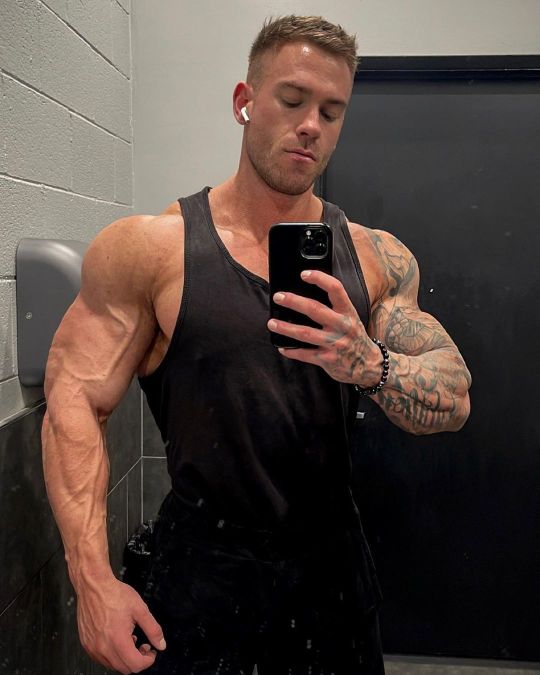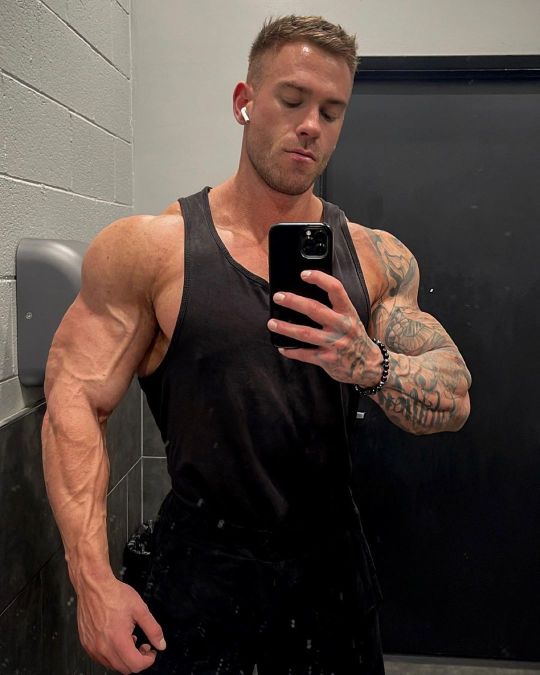#thomas bakke
Text

Now showing on DuranDuranTulsa's Horror Show...Tales From The Crypt Presents Demon Knight (1995) on glorious vintage VHS 📼! #movie #movies #horror #talesfromthecrypt #talesfromthecryptpresentsdemonknight #thecryptkeeper #williamsadler #BillyZane #dickmiller #ripdickmiller #cchpounder #jadapinkettsmith #ThomasHadenChurch #brendabakke #johnkassir #CharlesFleischer #ryanodonahue #henryrollins #vintage #vhs #90s #durandurantulsa #durandurantulsashorrorshow
#movies#movie#horror#tales from the crypt#tales from the crypt presents demon knight#the crypt keeper#William Sadler#Billy Zane#john kassir#jada punkett smith#cch pounder#dick miller#rip dick miller#thomas haden church#brenda bakke#Charles Fleischer#Ryan O'Donahue#vintage#vhs#90s#duran duran tulsa's horror show#duran duran tulsa#Spotify
19 notes
·
View notes
Text
¡¡FELIZ DÍA DEL POCKY!! 11.11

Para celebrarlo, escogí un OC para cada caja de Pocky que me encontré... fue difícil solo poner uno, pero aquí están algunos ¡¡que aproveche!!








#mine#jacques#kei#jin#monki#saki#muera#sebas#kaie#natsuko#andrei#bakk#mango#melon#mao#cesar#rai#thomas#dominik#aradia#diva#will#eric#bruno#june
9 notes
·
View notes
Text
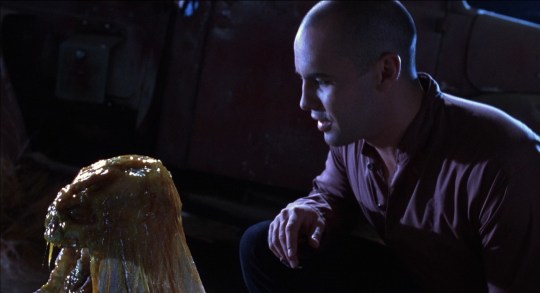
Billy Zane in Tales From the Crypt: Demon Knight (Ernest R. Dickerson, 1995)
Cast: Billy Zane, William Sadler, Jada Pinkett Smith, Thomas Haden Church, C.C.H. Pounder, Brenda Bakke, Dick Miller, Gary Farmer, John Kassir (voice). Screenplay: Ethan Reiff, Cyrus Voris, Mark Bishop. Cinematography: Rick Bota. Production design: Christiaan Wagener, Gregory S. Melton. Film editing: Stephen Lovejoy. Music: Edward Shearmur.
I was going to say that failure to access the 10-year-old boy in me kept me from enjoying Tales From the Crypt: Demon Knight, but then I remembered that when I was 10 years old I thought the Tales From the Crypt comic books were repulsive trash. So maybe I really enjoyed it more than that 10-year-old would have, which isn't saying much. It's still trash, but I've seen many movies that repulsed me more. There's a tongue-in-cheek element in its slimy rotting horrors (if there's a tongue to put in a cheek or a cheek to put one in) that doesn't exactly redeem it, but at least kept me watching. And it suggests that we have come to a point in the post-Christian era that what would once be regarded as blasphemous is now only a plot device: namely, the use of the blood of Jesus as a horror movie gimmick. Mostly, it made me feel a little sorry for the actors who have to go through their paces, trying to act but knowing that anything they do is going to be chopped up in the editing and stirred into a mess of special effects. Billy Zane as the demonic Collector and William Sadler as his heroic antagonist are the nominal leads, but Jada Pinkett Smith comes off best as the ex-con on work release who labors in the boarding house where most of the action takes place. She manages to create a character we can root for, which is all the otherwise well-worn plot needs. The frame story in which the Crypt Keeper (voiced by John Kassir) introduces things is unnecessary and mainly serves to promote the HBO series from which it's a theatrical spinoff.
2 notes
·
View notes
Photo



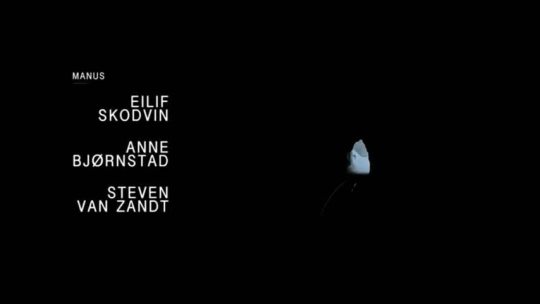


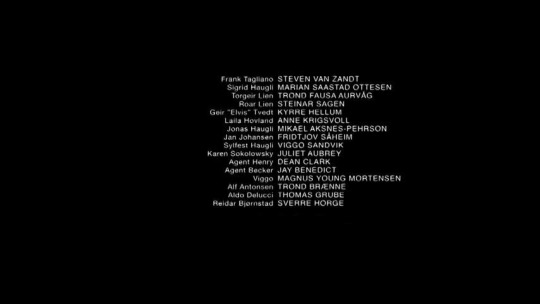
Lilyhammer - NRK1 / Netflix - January 25, 2012 - December 17, 2014
Black Comedy (24 episodes)
Running Time: 60 minutes
Stars:
Steven Van Zandt as Frank Tagliano / Giovanni "Johnny" Henriksen.
Trond Fausa Aurvåg as Torgeir Lien
Steinar Sagen as Roar Lien
Marian Saastad Ottesen as Sigrid Haugli
Viggo Sandvik as Sylfest Haugli
Mikael Aksnes-Pehrson as Jonas Haugli.
Fridtjov Såheim as Jan Johansen
Anne Krigsvoll as lensmann (chief of police) Laila Hovland
Robert Skjærstad as Roy "Fingern" Aass
Tommy Karlsen Sandum as Arne
Nils Jørgen Kaalstad as Dag Solstad
Tina Hovi as Yvonne Solstad
Finn Schau as politimester (chief constable) Arve Østli
Kyrre Hellum (season 1) as the police officer Geir "Elvis" Tvedt
Øyvind Blomstrøm (season 1), bass guitarist in El Cuero and drummer Svein Åge Lillehamre of the Lucky Bullets, who appear as backing musicians for (Kyrre Hellum's) Elvis cover-band in multiple episodes
Sven Nordin (season 1) as Julius Bakke
Harald Sørlie (season 1) as Baby Shop manager
Beate Eriksen (season 1) as Arne's striking mother
Jay Benedict (season 1) as FBI Agent Becker
Ingrid Olava (season 1) as herself
Thomas Grube (seasons 1–2) as Aldo Delucci
Greg Canestrari (season 1) as Jerry Delucci
Tim Ahern (seasons 1–2) as Robert Grasso
Kyrre Haugen Sydness (seasons 1–2) as Thomas Aune
5 notes
·
View notes
Text
Thomas Pidcock kan lide mesterskaber, men ikke øl
Thomas Pidcock vandt Amstel Gold Race, og han var meget glad efter løbet. Thomas Pidcocks gradient Billigt Cykeltøj så godt ud på podiet, men han fokuserede på sin øl. Thomas Pidcock viste to forskellige stemninger. Han kan lide mesterskabet, men kan ikke lide øl.
Bestigningerne og nedkørslerne af Amstel Gold Race gav Thomas Pidcock fordelen, da han endelig slog sin ærkerival Alpecin-Deceunincks Mathieu van der Poel. Faktisk kom Mathieu van der Poels nederlag fra klatring. Der var for mange klatreafsnit i løbet. Han bruger for meget fysisk energi på de konstante stigninger, og han er stadig ikke egnet til løb med flere stigninger. Thomas Pidcocks stigning var heller ikke let, men han viste sine fordele på ned ad bakke. Hans evne til at skabe et hul i nedadgående hastigheder var en væsentlig årsag til, at han vandt løbet. Sidste år vandt UAE Team Emirates' Tadej Pogačar Amstel Gold Race, mens Ineos Grenadiers' Thomas Pidcock sluttede på tredjepladsen. Tadej Pogačar havde ingen planer om at konkurrere i Amstel Gold Race i år, og Thomas Pidcock tog chancen og vandt begivenheden. Thomas Pidcock gjorde sin anden optræden i træk på Amstel Gold Race-podiet med et anderledes design til sin Ineos Grenadiers-Børn Cykeltøj.
Thomas Pidcock kan godt lide at stå ved prisuddelinger, men han kan ikke lide fejringen af at drikke øl. Han ville kun tage en lille slurk for at fejre sine top tre-placeringer, og han ville også hæve sit glas for at hylde fansene. At vinde Amstel Gold Race var ingen let bedrift for Thomas Pidcock, som stadig er ved at komme sig efter en skadet hånd i Paris-Roubaix. Thomas Pidcock udholdt faktisk den stikkende smerte i sine håndflader og fortsatte med at gennemføre kapløbet om at vinde mesterskabet.
0 notes
Text
Hallow-Watch: Tales from the Crypt: Demon Knight (1995)
Watched: 10/02/2023
Format: Criterion
Viewing: Second
Director: Ernest Dickerson
I didn't have HBO during most of the years when Tales From the Crypt was on television, so I was aware of the show, but didn't catch it very often. In general, I wasn't really wired for it at the time (I wasn't into horror), but in 1995, I was sort of going to see everything that came out.
My memory of the movie is that it's... fine. It seems like maybe it could have been better, and a 90 minute run-time, even with Crypt Keeper book-ends, was still maybe a bit much and at some point, you feel like you get it, and this could have been 75 or 80 minutes. The show was usually 30+ minutes, so you're essentially doing tight stories built on ironic twists, the hand of fate, etc... the kind of stuff you may be familiar with from any number of anthology shows that preceded it.
Here, they needed to tell a longer story, and so we get a bit of an actioner on top of the horror, and a larger cast. And what a cast! How weird.
I only really remembered Billy Zane, but we also have a very young Jada Pinkett (pre-Smith), Thomas Haden Church, CCH Pounder, William Sadler, Dick Miller, Charles Fleischer, Brenda Bakke and Traci Bingham is in there somewhere as a "Party Babe". It seems like the studio was like "hey, we're doing a Tales from the Crypt movie, and-" and everyone said "yes!".
The basic set-up is that William Sadler plays a guy on the run from an hilarious Billy Zane, who is a sort of Demon-guy. Sadler is protecting "the key" which will turn Earth back to a pre-"let there be light" state and release demons and darkness onto the world. He's trapped in a hotel (they keep calling a motel) built out of an old church along with the employees and residents of the motel, as well as some cops.
You've seen similar before as the cast bickers and fights and has their own little arcs and desires, which are exploited by Zane who uses their inner-most desires to get inside their heads and physically into the motel. And he's funny and charming as he does so.
The movie takes place in just a few locations over a single night, which helps wrangle the story, characters and budget. And makes for good horror-stuff.
There's a sort of post-80's/ we've-seen-Evil Dead 2 approach to some of it, and it's a pleasure to see so much done with puppets, creature design and practical FX. The demons running around are given animal-like legs I can't believe the actors could walk on, but they even climb stairs. There's some gore, but it's not, like, endless. It's more of a punchline and tone setting.
All-in-all, it's a fun movie. I'm not sure the format of Tales from the Crypt begs for a movie-length treatment, but it did make me think - there's no reason Max couldn't revive this show. Horror does great, in general, and it would be terrific to see stuff that relies on the sorts of plot twists and ghoulish morality tales that made TV horror and sci-fi work for decades. I don't know how much more I can get from another zombie-based TV show taking place in a world where they've never seen a zombie TV show before.
And, of course, it's kinda nice to have the Crypt Keeper making fun of the proceedings and the horrible fates of the characters instead of insisting this should all be taken very seriously, indeed. I'm a firm believer in the horror-host, from Elvira to Crypt Keeper to Count Floyd.
https://ift.tt/OG3LR4f
via The Signal Watch
https://ift.tt/D2JW9IH
October 03, 2023 at 09:49AM
0 notes
Text
Why America’s Supreme Court Has Ended Affirmative Action
The six-justice conservative majority overpowered the three liberal dissenters
— United States | Race and admissions | June 29th, 2023 | New York

Students relax outside on Campus at Harvard University. Image: Alamy
Forty-five years after allowing America’s universities to give limited consideration to race in admissions, the Supreme Court changed course on June 29th. Race-based affirmative action programmes in higher education, a 6-3 majority concluded, violate the Equal Protection Clause of the 14th Amendment.
The result in Students for Fair Admissions v Harvard (consolidated with Students for Fair Admissions v University of North Carolina) was no surprise. Affirmative action has been hanging by a thread for decades, with race-conscious admissions surviving by one-vote margins in Regents of University of California v Bakke in 1978, Grutter v Bollinger in 2003 and Fisher v University of Texas in 2016. When a six-justice conservative majority that was deeply sceptical of using racial criteria took shape in 2020, the demise of affirmative action seemed all but inevitable.
But the 237 pages of opinions—in which every justice but Samuel Alito, Amy Coney Barrett and Elena Kagan penned their own writings—show that deep divisions persist over how to reckon with America’s legacy of racial discrimination, and what kinds of ameliorative measures the law should allow.
In his majority opinion, Chief Justice John Roberts surveyed the history of affirmative-action jurisprudence and reprised a statement he wrote in 2007, just two years into his tenure. “The way to stop racial discrimination”, he wrote in Parents Involved in Community Schools v Seattle, “is to stop discriminating on the basis of race.” Sixteen years later, the chief offered an even pithier line: “Eliminating racial discrimination means eliminating all of it.” The Equal Protection Clause, he continued, quoting an 1886 decision, “applies ‘without regard to any differences of race, of colour or of nationality’—it is ‘universal in [its] application’.”
For decades, the basis of the Supreme Court’s justification for blessing affirmative action was “the educational benefits that flow from a diverse student body”. Although admissions officers were barred from using racial quotas to diversify their classrooms, they could use race as a “plus factor”—one consideration among many that could give black or Hispanic applicants an advantage over similarly qualified students who were not members of disadvantaged minorities. Chief Justice Roberts assailed this compromise. The benefits Harvard and the University of North Carolina claim for their admissions tips—“training future leaders in the public and private sectors”, “promoting the robust exchange of ideas”, “preparing graduates to ‘adapt to an increasingly pluralistic society’”—are neither concrete or measurable, he found. “Even if these goals could somehow be measured”, Chief Justice Roberts asked, “how is a court to know when they have been reached, and when the perilous remedy of racial preferences may cease?”
“The decision was joined by Justices Clarence Thomas, Samuel A. Alito Jr., Neil M. Gorsuch, Brett M. Kavanaugh and Amy Coney Barrett. Justice Sonia Sotomayor wrote the dissent and was joined by Justices Elena Kagan and Ketanji Brown Jackson, although Jackson did not participate in the Harvard case.”
The majority’s critique goes deeper. The ruling questions the very notion of diversity that universities claim to embrace and finds that the racial “categories are themselves imprecise in many ways”. To group together “all Asian students” is to show a lack of interest in “whether South Asian or East Asian students are adequately represented”. And while the universities claim to care about correcting for underrepresentation, Chief Justice Roberts wrote, they “would apparently prefer a class with 15% of students from Mexico over a class with 10% of students from several Latin American countries, simply because the former contains more Hispanic students than the latter”. Chief Justice Roberts concluded with a heavy charge: universities have “for too long” seen “the touchstone of an individual’s identity” not as “challenges bested, skills built, or lessons learned but the colour of their skin”.
Unsparing dissents from Justices Sonia Sotomayor and Ketanji Brown Jackson (who both joined the other’s writing, and who are each joined by Justice Elena Kagan) accuse the majority of abandoning a tool that has helped bring more inclusivity and equality to higher education and to American society more broadly. The decision, Justice Sotomayor wrote, will have a “devastating impact” in “an endemically segregated society where race has always mattered and continues to matter”. In a sparring match with Justice Clarence Thomas, who wrote a 58-page concurrence, Justice Jackson insisted that race-conscious admissions policies are in keeping with the original understanding of the 14th Amendment and remain crucial tools today. Justice Thomas’s colourblind reading of that amendment, she wrote, “refuse[s] to see, much less solve for, the elephant in the room—the race-linked disparities that continue to impede achievement of our great nation’s full potential”.
Despite its thorough rejection of systematic considerations of race, Chief Justice Roberts’s majority opinion left two windows open a crack. First, it acknowledged that individualised considerations of the impact of applicants’ racial identity are permissible: “nothing in this opinion should be construed as prohibiting universities from considering an applicant’s discussion of how race affected his or her life, be it through discrimination, inspiration or otherwise”. Second, in a footnote with outsize implications, the opinion exempted military schools like West Point and the Naval Academy from the ban on race-conscious admissions. The chief justice floated this exemption in last autumn’s oral argument. It seems to be in deference to the solicitor-general’s claim that in the context of military training, racial diversity is a matter of national security.
For Justice Jackson, the military academy carve-out is a craven move based on the notion that “racial diversity in higher education is only worth potentially preserving insofar as it might be needed to prepare Black Americans and other underrepresented minorities for success in the bunker, not the boardroom”. Justice Sotomayor called the first caveat “lipstick on a pig” inserted merely “to save face”. But in her closing, Justice Sotomayor seemed to welcome the narrow opening. “Although the court has stripped out almost all uses of race in college admissions”, she wrote, “universities can and should continue to use all available tools to meet society’s needs for diversity in education.” ■
1 note
·
View note
Text

Now showing on DuranDuranTulsa's Horror Show...Tales From The Crypt Presents Demon Knight (1995) on glorious vintage VHS 📼! #movie #movies #horror #talesfromthecrypt #talesfromthecryptpresentsdemonknight #thecryptkeeper #williamsadler #BillyZane #dickmiller #ripdickmiller #cchpounder #jadapinkettsmith #ThomasHadenChurch #brendabakke #johnkassir #CharlesFleischer #ryanodonohue #johnlarroquette #vintage #vhs #90s #durandurantulsa #durandurantulsashorrorshow
#movies#movie#horror#tales from the crypt#tales from the crypt presents demon knight#the crypt keeper#William Sadler#Billy Zane#jada pinkett smith#cch pounder#Charles Fleischer#john kassir#john larroquette#thomas haden church#dick miller#rip dick miller#brenda bakke#Ryan Donohue#90s#vintage#VHS#duran duran tulsa's horror show#duran duran tulsa#Spotify
6 notes
·
View notes
Photo

randstad - rookie
#randstad#rookie#thomas bakk#modular#techno#electronic#music#cover#cover art#artwork#design#album cover#collage#jam#experimental#lofi
2 notes
·
View notes

